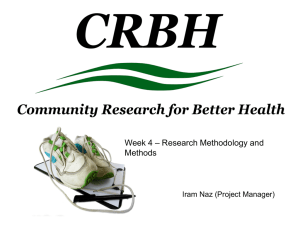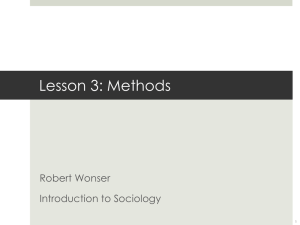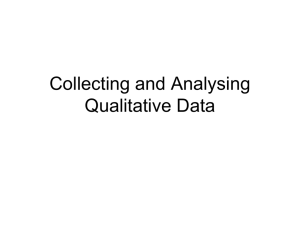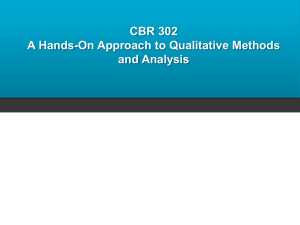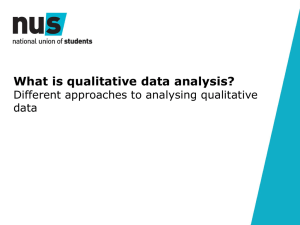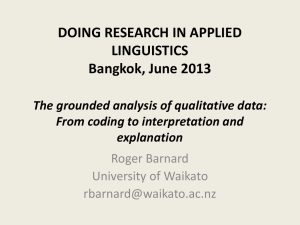QUALITATIVE DATA ANALYSIS - the political economy of war
advertisement
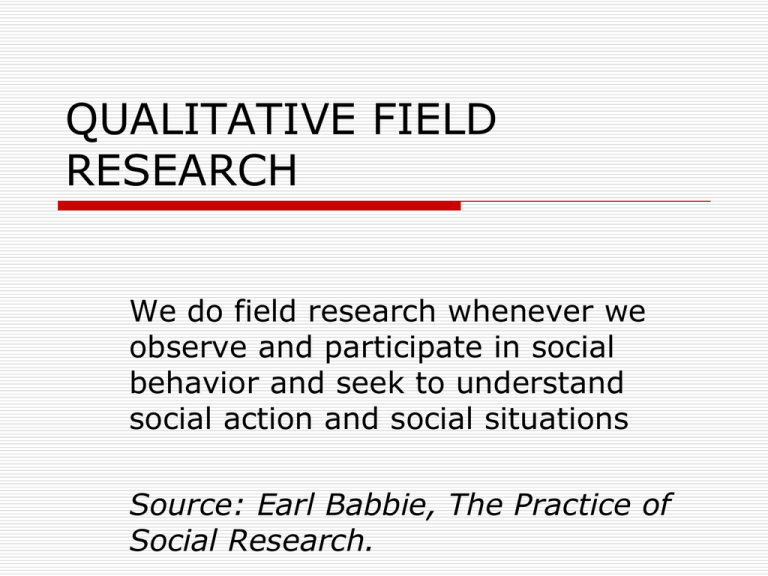
QUALITATIVE FIELD RESEARCH We do field research whenever we observe and participate in social behavior and seek to understand social action and social situations Source: Earl Babbie, The Practice of Social Research. Leads to a deeper and fuller understanding of the phenomenon, when we study it in its social context. Helps researchers recognize nuances of “attitudes and behaviors” the collectivity of social interaction as opposed to studying detached variables. Helps study processes over time, when taken together with the structure they are linked to. Elements of social life appropriate to Field Research (John Lofland) 1. Social Practices: Talking 2. Episodes: Events like crime, illness, divorce. 3. Encounters: Meeting and interaction among people. 4. Roles and social types associated with those roles. 5. Small groups 6. Formal Organizations 7. Settlements and ‘habitats’- small scale ‘societies’ 8. Social worlds of people 9. Subcultures and lifestyles Field Research offers the distinct advantage of studying social life in its ‘natural habitat.’ And capturing subtleties that might otherwise be lost in laboratory type research. Roles of the Observer Complete observer to complete participant continuum. Complete observer- researcher as Martiandetached/separateness, objectivity is a benefit but might miss insider understanding of phenomenon. Genuine participant Pretending to be a genuine participant Researcher as participant Deception is unethical but is often done (with debriefing at the end) for the sake of validity and reliability, to minimize “reactivity”- i.e. the subjects of social research might react to the fact of being studied, thus altering their behavior…(Hawthorne Effect). Types of EXPLANATION Idiographic (from Idio meaning unique e.g. idiosyncrasy) Seeks to explain a social event by an exhaustive set of unique causes- seeks total explanation, all causes Nomothetic Seeks to explain a social event by narrowing down causes to a few. Reliability & Validity Measurements should be 1. Reliable- consistency in measurement- objective 2. Valid- you are measuring what you are supposed to measure. Researchers Relations to the Subject Reflexivity- understanding based on anticipation of effects before acting. Taking on the “role” of the observed. Problems Research setting affects subjects responses Being moved by the personal lives of the people you study Power and status separation between researcher and subject (implicit assumptions about researcher superiority need to be dropped) Qualitative Field Research Paradigms 1. Naturalism: Linked to the Chicago School, earliest types of field research based on the positivist assumption that reality is “out there” and can be observed objectively E.g. William Foote Whyte’s, Street Corner Society (1943). Snow and Anderson (1987) Ethnography: A study that focuses on detailed and accurate description rather than explanation, preferably from an insiders point of view. Ethnographic Fallacy (Mitchell Dunier, 1999) Overgeneralization and oversimplification of the patterns observed. Going beyond descriptive exploration. Types of Ethnography Virtual Ethnography: using ethnographic techniques for inquiry into cyberspace. Auto-Ethnography: an ethnography technique that uses the researcher’s subjective experience to interpret data rather than interpreting it from the p.o.v of the researched (elite bias, given the social position of the researcher but may involve greater authenticity). 2. Ethnomethodology (Harold Garfinkel) Ethnomethodologists are skeptical about the way people report their experience of reality. People describe their world “as they make sense of it.” Breaching Experiments: Experiments designed to breach taken for granted norms of mundane everyday interaction to note reactions of people. Involves the researcher bracketing their expectations. Ethnomethodologists believe that naturalists lose the ability to understand the world if they use tools that are part of the world’s ‘logic.’ Discovering the inner logic of the world you study is more important. Ethnographers want to discover the world of the subjects from their point of view- how do the subjects see their world Ethnomethodologists want to uncover the methodology the people use in order to make sense of their world. In order to do this ethnomethodologists deliberately “breach” those rules in what they term breaching experiments. 3. Grounded Theory Method Barney Glasser and Anselm Strauss (1967) Inductive Theory Building; building theory from data, from an analysis of patterns, themes and common categories that are themselves discovered in observational data. Think comparatively, multiple viewpoints, skepticism, follow procedures involving comparison, sampling and asking questions, and systematic coding. Four Stages of the GTM 1. Comparing incidents applicable to each category : specifying concepts; [concept of social loss, reaction of nurses to the dying etc] 2. Integrating categories and their properties: what is the relationship between concepts; additional variables 3. Delimiting the theory: as relationships between concepts emerge, check which one is relevant and which one is not; [what cannot be considered as part of the relationship] 4. Writing the Theory EXPLANATION IN QUALITATIVE RESEARCH Discovering Patterns: John & Lyn Lofland, six different ways for looking for patterns: 1. 2. 3. 4. 5. Frequency: How often does it happen Magnitude: What is the level of it. How large Structures: What are the different types of it Processes: Is there any order among it Causes: is the occurrence different among variables 6. Consequences: How does it affect other things after it has occurred Differences between Quantitative and Qualitative research approaches Characteristic Quantitative Qualitative research research Logic of theory construction Deductive Direction of theory Begins from construction theory Inductive Begins from “reality’’ Verification Takes place after theory construction is completed Data generation, analysis & theory verification take place concurrently Concepts Defined before research “Flexible” concepts begins with orienting, sensitizing concepts Generalizations Inductive generalizations (use of inferential statistics) or hypotheticodeductive (use of hypothesis testing) Analytic, exemplar generalizations - i.e. sample units can act as typical representatives of a class or group of phenomena The epistemological inadequacy of induction. Robert Merton (1910-2003)- induction presents a weak form of evidence compared to deduction because facts that fit into an explanation (positive evidence) are not as strong as facts that fail to negate an explanation (deduction) based on falsification (Karl Popper 1902-1994) 4. Case Study and Extended Case Study Method. A case study focuses attention on a single instance of a social phenomenon- cases need not be a place or a group of people, it can also be a period of time. Case researchers seek an in depth idiographic understanding of the particular case under examination. Extended case study: discovering flaws in and then improving existing theories, that are clearly stated before the investigation in order to fill the “gaps and silences” in theory Cases cannot be generalized to the “whole”- have limited use other than informing quantitative research based on probability samples. 5. Institutional Ethnography Originally developed by Dorothy Smith (1978) to better understand women’s experiences by discovering power relations that shape those experiences: through discovering institutional practices that shape these realities. Discovering institutional power relations that structure everyday experiences: linking the micro-level world of experiences with the macrolevel world of institutions: the biography to the structure, i.e. using your sociological imagination. 6. Participatory Action Research The researcher’s function is to serve as a change brining resource to those being studied which are typically disadvantaged groups. The researcher works not only as a means of knowledge but as consciousness cultivator and helper in mobilization for social change Began with “third world” economic development research Qualitative Interviewing An interaction between the interviewer and the respondent in which the interviewer has a general plan of inquiry. In general, a qualitative interview is a conversation in which the interviewer establishes a general direction for the conversation and pursues specific topics raised by the respondent’s answers. Listen more than talk. Show interest in the other person but don’t let the conversation veer off course. Seven Stages to complete the interview process (Steinar Kvale 1996) 1. 2. 3. 4. 5. 6. 7. Thematizing- clarify the purpose of the interview. Designing based on purpose of interview Interviewing Transcribing Analyzing in terms of the themes in 1. Verifying for reliability and validity Reporting Focus Groups Group interviewing In a focus group 5 to 15 people are brought together (typically) in a private environment to engage in a guided discussion of some topic. A good way to generate substantive questions for survey research (preresearch technique). Recording Observations Some can be anticipated, others emerge during the course of the field research. Take as much detailed notes as you can, even though most will be ‘wasted’ in the end. Observing and recording are skills that improve with practice. Strengths and Weakness of Field Research High on validity and forming descriptive concepts Low on reliability, generalization success and uncovering causation. Qualitative Interviewing Field Research involves going where the “action” is and observing, listening and recording. Qualitative interviewing unlike surveys involve detailed interaction of researcher with interviewee, pay attention to non verbal aspects of the response as well. Mix observation/field research with the interview not losing focus of the entire surrounding ‘situation’: be reflexive, think about the unsaid. Semiotics- part of qualitative research The science of signs Has to do with symbols and meanings Commonly associated with content analysis Semiotics is based on language but other multiple sign systems e.g. mathematics, Morse code etc exist. Meaning is not intrinsic to the sign but resides in the mind, that emerges as a consequence of the ‘social situation’- link between expression and content. Therefore semiotics is a social science- agreed meaning among a group about symbols and signs and their socially desirable expression. In reading signs and their meanings note the latent, i.e. hidden meanings, subliminal messages Conversation Analysis (CA) Conversation is a socially structured activity Part of ethnomethodology, that tries to uncover the implicit assumptions and structures in social life. Simple example of structure: what do you do when you talk? Take turns. Understand contextually, analyze the pauses etc. When an outsider enters a group he or she breaches rules of conversation- note the reactions during qualitative interviews they are important part of the research QUALITATIVE DATA PROCESSING Coding The process of converting raw data into standarized form for the purpose of analyzing your research problem. It involves the logic of conceptualization that we studied earlier. You have a choice in coding between generality or depth (specificity) or both. You can code the manifest content (the surface, explicit content) and the latent or deeper meaning that emerges from the patterns (latent coding) The “concept” is the organizing principle for qualitative coding. Manual coding- the file put code name on the tab and the data that goes with it in the file or its location in some other file. Types of coding- from broad to specific Open coding- break up data into discrete numbered parts and examine similarities and differences. Axial Coding- identify Core concepts that are central to your study AFTER open coding, regrouping data and looking for analytical concepts beyond open coding. Selective Coding- identifying THE central code in the study that organizes or orders all the other concepts. Very Important Negative case testing –Bruce Berg (a technique for qualitative hypothesis testing), so that the methodology can proceed beyond mere positive pattern formation and the pre-experimental to an experimental/falsification based undertaking Find the cases that contradict the general pattern and studying them in detail Memoing Writing memos and notes to yourself and others during the qualitative project and during coding Code notes: code labels and their meanings Theoretical notes: that go with various codes Operational notes: methodological issues Concept mapping Qualitative diagrams like some of the ones handed out during the semesterrelationship between concepts presented graphically. Visual portrayals help you summarize, think and invent new relationships, can help data collection in the future and organize your theory.

